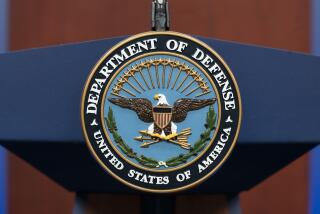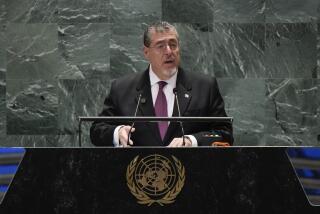‘They’re Not There to Bait Anybody,’ U.S. Aide Says : Troops Going to Panama Know the Region’s Terrain
- Share via
WASHINGTON — Most of the military units being sent to Panama by President Bush in “Operation Nimrod Dancer” are rapidly deployable and schooled in the peculiar political and military terrain they are likely to encounter in Central America.
The initial wave of deployments to Panama will bring more than 1,000 lightly armed foot soldiers into Panama quickly. But a second wave of troops will introduce both heavier firepower and the kind of armored transportation that U.S. troops will need to evacuate civilians, if the violence in Panama’s streets escalates.
With the addition of 1,881 U.S. troops to 10,000 already in place in Panama, U.S. forces would be better able to repulse an attack on U.S. bases and the Panama Canal should the Panamanian Defense Forces try to mount an assault, U.S. officials said.
Twofold Mission
“They are combat troops. They are there to protect American lives and, if necessary, to protect the Panama Canal,” said National Security Adviser Brent Scowcroft. But Scowcroft added that the troops also will be used to exercise “one of the important treaty rights . . . the right of unimpeded travel for official convoys and troops throughout the country.”
One defense official said that while the troops probably will travel on some Panamanian streets, “they’re not there to bait anybody.”
Two battalions from the Army’s 7th Light Infantry Division and a company from the Marine Corps’ 2nd Expeditionary Force--a total of 1,055 troops expected to begin arriving by today--have trained extensively in Central America.
In March, 1988, when forces of Nicaragua’s Sandinista government allegedly made incursions into Honduras, the Reagan Administration dispatched two battalions of the 7th Light Infantry Division to Honduras in an “emergency readiness exercise” called Operation Golden Pheasant.
Routinely Sent to Area
Elements of the Marine Corps’ 2nd Expeditionary Force, ordered to leave Camp Lejeune, N.C., immediately for Panama, are routinely sent to the troubled Central American nation, where they hone their skills in fighting brush-fire wars at the Army’s Jungle Warfare Training School there.
Both units are among the military’s quick-reaction forces that can move to trouble spots lightly armed and highly mobile. While the Army’s light infantry moves by foot or hitches rides on local trucks and helicopters, the Marine Corps company gets around in light armored vehicles--specially designed eight-wheel dune buggies armed with a 25-millimeter machine gun as well as a 7.62-millimeter machine gun.
The 7th Infantry Division, formed in 1985, is one of four active-duty U.S. light infantry divisions created by the Army since the early 1980s. Its ranks of 10,700--smaller than mechanized divisions of about 17,000--are swelled with many more riflemen than in the Army’s more heavily armored divisions.
Heavy Firepower
But it is the addition of an Army mechanized infantry battalion--a total of 726 soldiers from Ft. Polk, La.--that will bring big guns and heavy armor to Panama within a few days. Pentagon spokesman Dan Howard said that the troops and 59 armored personnel carriers, six mortar carriers and 106 support vehicles will arrive via cargo ship in two to three days.
“They’re taking some lighter forces and putting them in with some backup,” said Jeffrey Record, a senior fellow with the conservative Hudson Institute and a specialist in the tactics of Third World warfare. “And if the situation continues to deteriorate, the Ro-Ro (roll-on/roll-off ship) is on the way” with heavier equipment.
“Their first mission is to protect the facilities in case there’s a run on them,” said Record. “They obviously want to have a great deal of mobility on the ground, which they’ll get in spades when the battalion from Ft. Polk gets there.”
Record said that if the tension escalates still further, the Pentagon may wish to send additional helicopter units to Panama to increase the troops’ firepower and mobility. Pentagon spokesman Howard said that the United States has “substantial (helicopter) resources already on the ground in Panama.”
Among those, said Ft. Ord spokesman James Davis, is a 200-man chopper unit from the 7th Division which trains regularly in Panama.
More to Read
Sign up for Essential California
The most important California stories and recommendations in your inbox every morning.
You may occasionally receive promotional content from the Los Angeles Times.











